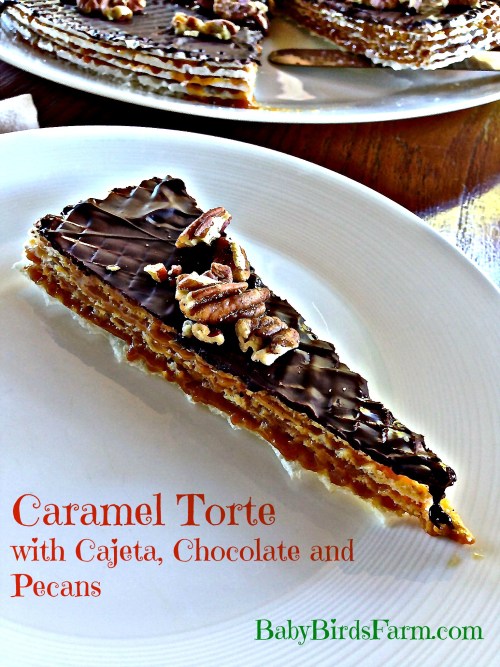Before living on the Bird Family Farm in a quiet part of San Diego, I lived in the neighborhood of North Park. Well, my side of the street was North Park, but across the street was City Heights. Also across the street was a small, family run Mexican market. They had fresh tortillas and Mexican canned goods, cheeses and candies. I love caramel, and was buying these round candies labeled “cajeta” for a while before I figured out that the picture of a goat on them probably meant that it was made with goat milk. It was too late to be grossed out as I was already a fan. The slight tang from the “goatiness” balances out the sugary sweetness better than cow’s milk can.

Fast forward to this spring and with my first surplus of goat milk from our co-op I knew I wanted to try making some form of goat milk caramel. I found a recipe for Rick Bayless’ cajeta caramel sauce and haven’t turned back. I’ve been a fan of Rick Bayless ever since I saw his show on PBS. If you are not familiar with him, he is a white American guy who makes Mexican food look authentic and delicious. I remember that in the first show I saw he was featuring a recipe called Chiles en Nogada and I was dying to try it. (I’ve since had it here in San Diego and in San Jose del Cabo, Mexico.)
Pronounced “ka-HEY-ta,” cajeta is traditionally made from goat milk and sugar, slowly reduced and caramelized. Think of dulce de leche meets sweetened condensed milk. It is often served as a syrup over pancakes and cakes or stirred into coffee. I like to add a vanilla bean to the recipe. Not only are the black flecks beautiful, it adds an almost custardy taste to the cajeta.
This is NOT a “quick and easy” recipe. Plan on the cooking taking an hour and a half. You do not need to stir constantly until the very end, but during most of the cooking you do need to stir periodically, scraping the bottom and the sides with a heat proof spatula. The only tricky part is feeling confident on when to stop cooking it. But no worries there! It’s just a matter of preference. Reduced less time it will be more syrupy, and cooked longer it will be thicker, almost pudding like when chilled.
Cajeta Recipe: Step by Step with Pictures
-

-
Cajeta ingredients. (Not shown: 2 cups of sugar. I must’ve had a mental block.)
-

-
Add sugar to milk, bring up to a simmer.
-

-
Split a vanilla bean and scrape out the seeds.
-

-
Add vanilla bean and half a stick of cinnamon to the milk and sugar.
-

-
Dissolve 1/2 teaspoon of baking soda in a small amount of water. Add it to the milk.
-

-
Stir occasionally, scraping the sides and bottom, as the cajeta slowly reduces.
-

-
The milk and sugar will slowly start to caramelize and reduce.
-

-
Getting closer… you could even stop here for a thinner syrup.
-

-
All done… the bubbles are appearing almost “glassy.”
-

-
Pour into a quart sized mason jar.
-

-
Fresh Cajeta — Baby Bird’s Farm and Cocina
-

-
Fresh cajeta straight from the jar — Baby Bird’s Farm and Cocina
Recipe adapted minimally from
Rick Bayless’ Cajeta • Makes about 3-4 cups
- 2 quarts goat’s milk or a combination of goat’s milk and cow’s milk—or even with all cow’s milk (use whole milk in all cases)
- 2 cups sugar
- 1/2 of a cinnamon stick
- 1 vanilla bean, split lengthwise and scraped
- 1/2 teaspoon baking soda dissolved in 1 tablespoon water
1. Simmer the cajeta. In a large (6- to 8-quart) pot, combine the milk, sugar and cinnamon stick and set over medium heat. Stir regularly until the milk comes to a simmer (all the sugar should have dissolved by this point). Remove the pot from the heat and stir in the dissolved baking soda—it’ll foam up if the goat’s milk is acidic. When the bubbles subside, return the pot to the heat.
Adjust the heat to maintain the mixture at a brisk simmer (too high and the mixture will boil over; too low and the cooking time will seem interminable). Cook, stirring regularly, until the mixture turns pale golden, more or less one hour.
Now, begin stirring frequently as the mixture colors to caramel-brown and thickens to the consistency of maple syrup (you’ll notice the bubbles becoming larger and glassier). Stir regularly so nothing sticks to the bottom of the pot. Test a couple of drops on a cold plate: When cool, the cajeta should be the consistency of a medium-thick caramel sauce. If the cooled cajeta is thicker (almost like caramel candy), stir in a tablespoon or so of water and remove from the heat; if too runny, keep cooking.
2. Finish the cajeta. Pour the cajeta through a fine-mesh strainer set over a bowl or a wide-mouth storage jar. (Or simply fish out the vanilla pod and cinnamon.) When cool, cover and refrigerate until you’re ready to serve. Warming the cajeta before serving makes it extra delicious.
Notes:
Cajeta keeps for a month or more in the refrigerator. Keep it tightly covered to keep it from absorbing other flavors. I have also frozen it, although for only a month, and the defrosted cajeta was just as good.










































